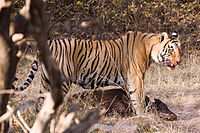|
Vikidia currently has 4,625 articles. Improve it! |
|
Join Vikidia: create your account now and improve it! |
Tiger
The tiger (scientific name : Panthera tigris) is a mammal. It is the largest member of the cat family, the Felidae. There are 41 members of the Felidae, including the domestic cat. These animals are called felines.
All tigers are meat-eaters (carnivores) that live in the jungles, grasslands, and forests of India and southeastern Asia. There are six living subspecies of tiger.
The tiger is an endangered species. Its living areas are disappearing due to human developments, and its numbers are declining due to poaching. The tiger has long been featured in literature, especially children's stories.
Subspecies[edit | edit source]
There are 10 recognized subspecies of tiger. One became extinct in prehistoric times. The remaining subspecies all survived at least into the mid-20th century. The tiger has 6 living subspecies, and 3 extinct (†) subspecies. These three were made extinct sometime in the last two centuries.
- Bengal tiger (Panthera tigris tigris) is native to the Indian subcontinent. In 2010, it became endangered. They are the second largest tiger, after the Siberian tiger. There are less than 2,500 of these tigers. There are about 1,500–1,900 in India, 440 in Bangladesh, 124–229 in Nepal and 67–81 in Bhutan.
- Indochinese tiger (Panthera tigris corbetti) is found in Myanmar, Thailand, Laos, Cambodia, Vietnam, and southwestern China. This tiger is also known as the Corbett's tiger, named after Jim Corbett. Indochinese tigers are darker in color than the Bengal tiger, and have narrow stripes which usually break up into a row of spots. It has been listed as endangered.
- Siberian tiger (Panthera tigris altaica) is the largest cat in the world. They are also known as the "Amur Tiger". They live in eastern Russia's birch forests. Some are found in China and North Korea. It is estimated that there are around 400 to 500 Siberian tigers left in the wild.
- Sumatran tiger (Panthera tigris sumatrae) is the smallest tiger subspecies. It is critically endangered. It is hunted for its fur and other body parts, and its habitat is being lost. It is estimated that there are only a few hundred Sumatran tigers left in the wild. The Sumatran tiger is found only on the Indonesian island of Sumatra. They live in low and highland areas, to mountainous jungles and peat swamp forests.
- South-Chinese tiger (Panthera tigris amoyensis) is the second smallest tiger. It is found on mountains, and in temperate, upland forests of southern China. There are now 20-30 of them left in the wild and 60 left in captivity. It is one of the world's 10 most endangered animals and the most endangered of the six surviving tiger subspecies. The South-Chinese tiger is also known as the Chinese, Amoy, or Xiamen tiger.
- Malayan tiger (Panthera tigris jacksoni) was discovered in 2004. It was thought they were Indochinese tigers, but they now have their own subspecies. They have the same length and weight as the Indochinese tiger. They live in southern Malaysia. They are an endangered species.
- †Javan tiger (Panthera tigris sondaica)
- †Bali tiger (Panthera tigris balica)
- †Caspian tiger (Panthera tigris virgata)
Description[edit | edit source]
Tigers can weigh up to 850 lbs and measure up to at least 11 ft. The animal is distinctive for its reddish-orange coat, black stripes, and snow white belly. No two tigers have the same pattern of stripes. These stripes act as camouflage when the tiger is hunting.
Sometimes there are tigers with different colors. There are white tigers that have white fur with black stripes. Some even have pure white fur. They have blue or green eyes. Most Bengal tigers have orange fur. The white coat only appears once in every 10,000 births.
Distribution and habitat[edit | edit source]
Tigers were once widespread in Asia, but today they are found mostly in India and southeastern Asia. They live in the taiga of Russia, open grasslands, and tropical mangrove swamps.
Tiger populations are declining; people hunt them for their skin and destroy the habitats they live in. The Bengal tiger has the largest population with 3,500 left in the wild. The South-Chinese tiger has the smallest population with only 20 or 30 left in the wild and about 60 in captivity.
Feeding[edit | edit source]
All tigers are meat-eaters (carnivores). They eat many different types of prey, mostly other large mammals. Some examples are deer, monkeys, wild pigs, tapirs and other animals found in Asia.
Some tigers may eat up to 50 lbs of meat a day. Tigers kill their prey by clamping down on the prey's throat and suffocating it.
Endangered species[edit | edit source]
There are an estimated 3,000 tigers in the wild. Their numbers have seriously declined since 1900 due to habitat loss and poaching. The tiger is an endangered species.
Tigers in literature[edit | edit source]
Famous literary tigers include the one "burning bright" in William Blake's poem "The Tyger"; Shere Khan in The Jungle Books by Rudyard Kipling, the four melting tigers in Little Black Sambo, Tigger in the Winnie the Pooh books by A. A. Milne, and Hobbes in the comic strip Calvin and Hobbes.

|
Animals Portal — All articles about animals |

|
Endangered Species Portal — All articles about endangered species |





